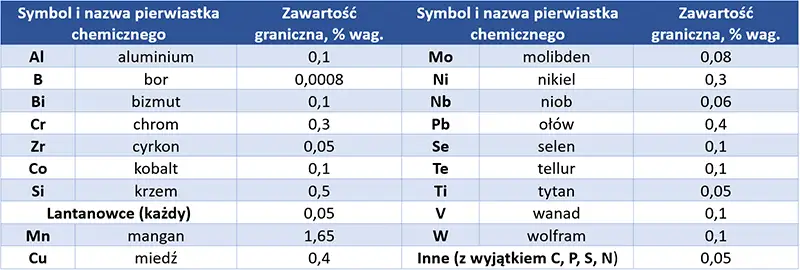
Alloy and unalloyed steels
What is steel?
Steel is an iron-carbon alloy with a carbon content of up to 2%, which has been plastically processed and heat-treated. In addition to carbon, the alloy contains other chemical elements, some of which come from the metallurgical process, including admixtures such as Mn, Si or Al, and impurities such as S or P, which have an adverse effect on the finished product, causing cold and hot embrittlement of the steel.
However, in order to improve the properties of steel or to produce a material for a specific application, alloying elements are deliberately introduced to enable the desired structure, which significantly affects the mechanical properties in plastic processing, corrosion resistance, heat resistance, heat resistance, etc.
According to the European standard PN-EN 10020:2003, due to the chemical composition of steel, there are distinguished:
- unalloyed ste els also called carbon steels, in which the content of each element is less than the limits shown in Table 1,
- alloy steels, in which the content of at least one of the elements is equal to or greater than the limit values shown in Table 1.
Table 1. limit concentration of elements in non-alloy steels

In addition, some steels whose elemental content is different from that given in the PN-EN are also classified as alloyed steels.
Alloy steels, due to their total elemental concentration, are conventionally divided into three groups:
- low-alloy steels, in which the concentration of any one element, except C, is less than 2%, and the total sum of elements does not exceed 3.5%,
- medium alloyed, in which the concentration of one element, except C, is between 2 and 8% or the total sum of elements does not exceed 12%,
- high-alloyed, in which the concentration of one element is greater than 8%, and the total sum of elements does not exceed 55%,
Depending on which element in the alloy steel is predominant, we also distinguish steels, among others:
- manganese steels - characterized by high strength properties are often used for the construction of shot blasting machines, safes, wear-resistant parts in grinding equipment, mill plates, etc.
- silicon ste els - as a soft magnetic alloy it is used in the power, electronics and military industries and applied to the manufacture of motors and micro motors, transformers, relays and magnetic switches, etc.
- chromium-nickel steels - often used in nuclear, engineering, food, pharmaceutical, transportation, etc. and other industries.
In the world's steel production, about 85% is made up of unalloyed structural steels, while the remaining 15% is alloyed machine and structural steels, as well as heat-resistant and heat-resistant steels, tool steels, and steels with special physical properties. The production of steel products with high mechanical properties makes it possible to make lightweight structures with high load-bearing capacity and extended service life, vehicles with increasingly low fuel consumption and harmful exhaust emissions.
Back to the main blog page
Back to blog
